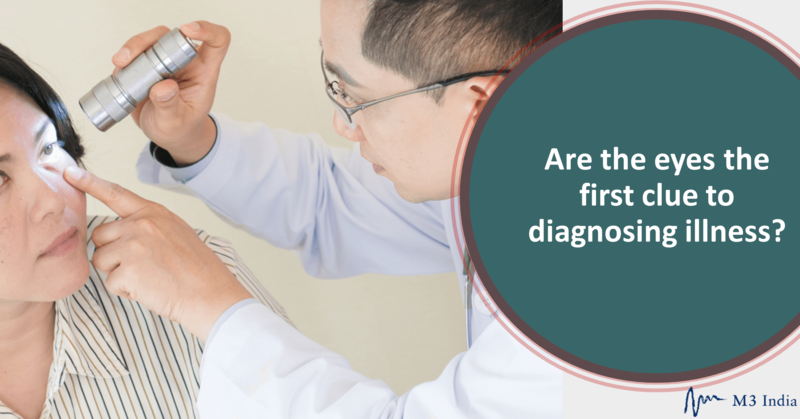Are the eyes the first clue to diagnosing illness?
M3 Global Newsdesk Nov 23, 2019
The eyes are the window to the soul—and the body. Eye doctors can tell a lot about your overall health just by looking in your eyes. That's because the eye is the only place in the body that provides an unobstructed view of blood vessels, nerves, and connecting tissue. As a result, eye examinations and tests can provide earlier diagnoses on diabetes, high blood pressure, cancer, multiple sclerosis, and other conditions.

“There is an intricate communication between the eye and the rest of the body through the blood, blood vessels, and nerve connections. The eyes can reflect illness that begins in another tissue far away from the eyes themselves,” according to ophthalmologist Rebecca Taylor, MD, on the American Academy of Ophthalmology website.
Here are just a few of the many conditions that may be detectable in your eyes before anywhere else in the body.
Diabetes
Because blurred vision is one of the first signs of diabetes, eye doctors are often the first to diagnose patients with this condition. Blurred vision may occur in people with prediabetes or diabetes due to increased plasma glucose levels that alter the shape of the eye’s crystalline lens.
But blurred vision can also be a result of diabetic retinopathy, in which damaged blood vessels in the retina can weaken, bulge, or seep into the retina. Left untreated, this leads to diabetic macular edema, in which damaged blood vessels leak fluid that causes swelling in the macula—the area of the retina responsible for central vision. Eye doctors commonly diagnose diabetes in these patients even when they haven’t exhibited any other diabetic symptoms.
On a related note, researchers in Australia have developed a way to test the tear film in the eye to screen for diabetic peripheral neuropathy in people with type 1 diabetes. Peripheral neuropathy affects nearly half of people with diabetes, causing numbness, weakness, pain, and other symptoms in the hands, legs, and feet. But it can be very difficult to diagnose in the early stage. These researchers predict that eye doctors—or any healthcare professional—will be able to simply take a sample of the patient’s tears to identify this diabetic complication as early as possible. So far, the test is only applicable to those with type 1 diabetes.
High blood pressure
Of the 103 million US adults with high blood pressure, about 20% don’t even know that they have it. Again, eye doctors are frequently the first clinicians to identify this condition.
High blood pressure in the body goes hand-in-hand with high blood pressure in the eye. This results in narrowing of the blood vessels in the retina as well as other characteristic ocular changes, resulting in hypertensive retinopathy. The severity of hypertensive retinopathy in the eye generally correlates with the severity of hypertensive damage in other organs, such as the brain, heart, and kidneys. Swelling of the optic disk (papilledema) indicates that blood pressure is extremely high and requires immediate treatment.
Cancer
Cancer commonly metastasises to the eye. The most typical intraocular metastases arise from breast or lung cancers, but they can be related to brain tumors, as well. Ocular symptoms don’t often occur, but malignancies may have characteristic appearances in the eye. A patient with leukemia, for instance, may present with retinal hemorrhages.
Because ocular metastases are sometimes the smallest clinically detectable lesions of disseminated malignancies, the eye doctor can help evaluate the efficacy of systemic cancer treatment by regularly monitoring these lesions.
Multiple sclerosis
Several years before multiple sclerosis becomes detectable, the first harbinger may appear in the eye. Optic neuritis—an acute, painful vision loss that occurs in one or both eyes over a few days to 2 weeks—can be its initial manifestation. After one episode of optic neuritis, 70% of eyes recover on their own within 3 to 6 months. But within the next 5 years of such an episode, more than 40% of young women (age 20 to 40 years) will manifest signs and symptoms of multiple sclerosis.
Myasthenia gravis
About 75% of patients with myasthenia gravis present with ocular manifestations. Of these, about 20% have only ocular manifestations. Although myasthenia gravis may affect any skeletal muscle, muscles that control eye and eyelid movement, facial expression, and swallowing are most frequently affected.
The hallmark of this chronic autoimmune neuromuscular disease is muscle weakness that worsens after activity and improves after rest. Because weakness is a common symptom of many disorders, the diagnosis of myasthenia gravis is often overlooked or delayed in people with mild or localized muscle weakness. In most cases, the first noticeable symptom of myasthenia gravis is drooping of one or both eyelids (ptosis) due to weakness of the eye muscles. And ptosis can lead to dry eye, another characteristic symptom.
Alzheimer disease
Within the past few months, news reports announced that a simple eye test could diagnose Alzheimer disease. The truth is that this eye test isn’t fully proven just yet—but researchers are working on it. Using a very high-tech ocular angiography scanner, the researchers found that people with Alzheimer disease had fewer blood vessels and less blood flow in certain parts of the retina than people with mild cognitive impairment as well as healthy controls. They concluded that changes in the microvasculature of the retina might be linked to small blood vessel changes in the brains of people with Alzheimer disease.
While more research must be done, the researchers hope that they will eventually have a test that signals changes in the eye before any changes in cognition become detectable.
This story is contributed by John Murphy and is a part of our Global Content Initiative, where we feature selected stories from our Global network which we believe would be most useful and informative to our doctor members.
-
Exclusive Write-ups & Webinars by KOLs
-
Daily Quiz by specialty
-
Paid Market Research Surveys
-
Case discussions, News & Journals' summaries